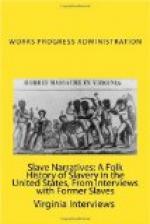“After long weeks of flight, when the homes of the Indians had been reduced to ashes, the long trail still carried them away from their beautiful valley. My greatgrandfather and his squaw became acquainted with a party of Indians that were going to the canebrakes of Alabama. The pilgrims were not well fed or well clothed and they were glad to travel towards the south, believing the climate would be favorable to their health.
“After a long and dreary journey, the Indians reached Alabama. Rachael had her youngest papoose strapped on to her back while John had cared for the larger child, Lucy. Sometimes she had walked beside her father but often she had become weary or sleepy and he had carried her many miles of the journey, besides the weight of blankets and food. An older daughter, Courtney, also accompanied her parents.
“When they neared the cane lands they heard the songs of Negro slaves as they toiled in the cane. Soon they were in sight of the slave quarters of Patent George’s plantation. The Negroes made the Indians welcome and the slave dealer allowed them to occupy the cane house; thus the Indians became slaves of Patent George.
“Worn out from his long journey John Hawk became too ill to work in the sugar cane. The kindly-disposed Negroes helped care for the sick man but he lived only a few months. Rachel and her two children remained on the plantation, working with the other slaves. She had nowhere to go. No home to call her own. She had automatically become a slave. Her children had become chattel.
“So passed a year away, then unhappiness came to the Indian mother, for her daughter, Courtney, became the mother of young Master Ford George’s child. The parents called the little half-breed “Eliza” and were very fond of her. The widow of John Hawk became the mother of Patent George’s son, Patent Junior.
“The tradition of the family states that in spite of these irregular occurrences the people at the George’s southern plantation were prosperous, happy, and lived in peace each with the others. Patent George wearied of the Southern climate and brought his slaves into Kentucky where their ability and strength would amass a fortune for the master in the iron ore regions of Kentucky.
“With the wagon trains of Patent and Ford George came Rachel Hawk and her daughters, Courtney, Lucy and Rachel. Rachel died on the journey from Alabama but the remaining full blooded Indians entered Kentucky as slaves.
“The slave men soon became skilled workers in the Hillman Rolling Mills. Mr. Trigg was owner of the vast iron works called the “Chimneys” in the region, but listed as the Hillman, Dixon, Boyer, Kelley and Lyons Furnaces. For more than a half century these chimneys smoked as the most valuable development in the western area of Kentucky. Operated in 1810, these furnaces had refined iron ore to supply the United States Navy with cannon balls and grape shot, and the iron smelting industry continued until after the close of the Civil War.




